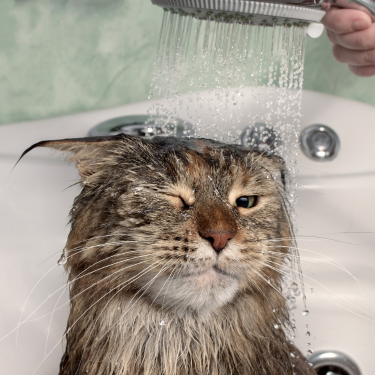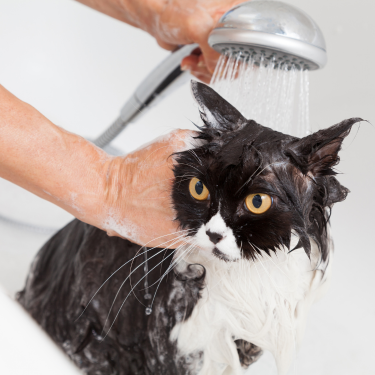Do Cats Need Baths? | Tips for Bathing a Cat.
Bathing a cat can be a challenging task, but it's sometimes necessary for keeping your feline friend clean. In this article, we'll explore Do Cats Need Baths? and provide practical tips for bath time. From understanding how to bathe a cat and knowing the best techniques to wash a cat, you'll find everything you need to keep your cat clean and happy.

Cats don't usually need baths, but there are some exceptional circumstances. If they've rolled in something they can't clean off themselves or have long hair that's become matted, a thorough wash might be necessary. However, bathing a cat can be quite challenging, as most cats really dislike baths and find the experience very stressful.
That said, there are rare occasions when you must bathe your cat. In such cases, there are methods to make bath time more comfortable for both you and your feline friend. Read on to learn when a cat needs a bath and how to wash your cat to keep them clean and happy.
How often should you bathe a cat?
In general, you should bathe your cat every 4-6 weeks, depending on their grooming habits and environment. If your cat is more outdoorsy and gets dirty often, or if your cat has a skin condition, they might need extra help to stay clean. Elderly, overweight, or long haired cats may also need assistance with bath time to ensure their cat coat is properly maintained. Short haired cats generally need less frequent bathing compared to long haired breeds, which may require more regular washes to help reduce excess oils and keep their fur clean.
Hairless breeds need more frequent baths, ideally once a week, to manage their excess oil production. To make bath time less stressful for your cat, use a gentle cat shampoo and have a large towel ready. Spending time to brush your cat before bathing can help, and offering treats afterward can make the experience more positive. Let your cat know that bath time isn’t as scary as it might seem, this will help them associate it with something good and reduce their stress.
Before you bathe your cat
Gather everything you need before bath time to make the process smoother for both you and your cat. Here’s a checklist:
- A large plastic bucket, sink, or bath lined with a non slip mat to use as a cat bath.
- A cat shampoo specifically formulated for feline skin and fur.
- A cat conditioner, if necessary, to help manage long haired or dry cat fur.
- One or two large towels to help dry your cat after the bath.
- A brush to remove any matted fur and knots, especially for long-haired breeds.
Having these items ready will help you efficiently bathe your cat, whether they need frequent washes due to their skin condition or just a regular clean. Offering treats after the bath can make the experience more positive and reduce any stress for your cat.

How to bathe a cat?
Choose the right time
To ensure that bathing is a positive experience for your cat, it’s crucial to choose the right time. If your cat is too alert or irritable, the bath can quickly become stressful. Aim to bathe them when they are more relaxed and tired. Try playing with them beforehand to burn off excess energy before heading to the bathroom.
Prepare the cat
Before you bathe your cat, trim their nails to prevent scratches and brush their coat to remove dead skin and loose hair. To help your cat stay comfortable, use cotton balls to gently plug their ears, keeping excess water from causing discomfort. This preparation ensures that bath time is less stressful and more effective in keeping your cat clean. By spending time on these steps, you'll help make the experience more positive for your cat and reduce any potential issues.
Place everything you need at hand
To ensure a smooth bath time, place a rubber mat or folded towel in the sink or tub. This provides a non slip surface, helping your cat stand securely and remain calm during the bath.
When you bathe your cat to wash away any unpleasant or irritating substances, always wear gloves to protect your skin. If your cat has come into contact with toxic substances, it's best to visit the vet first.
Having treats available is also a good idea. Use them as positive reinforcement to encourage good behavior and help your cat associate bath time with positive experiences. This approach helps reduce stress and makes the process more pleasant for your adult cat.
Bathing and drying the cat
First, fill the bath with just enough warm (not hot) water to bathe your cat, and gently lower them into it. Avoid overfilling the bath, as this can increase your cat's anxiety. Since the sound of running water can unsettle cats, prepare the water before bringing them into the bathroom. For their comfort, use a small jug instead of the shower head to wash your cat.
Next, use an unscented cat shampoo and dilute it with 1 part shampoo to 5 parts water. To prevent allergic reactions, patch test the shampoo on a small area of your cat’s skin before applying it to their entire body.
During bath time, take it slow and keep noise levels low to avoid stressing your cat. For cleaning their face, use a wet washcloth and gently wipe.
After the bath, wrap your cat in a large towel to dry them off. You can also use a blow dryer on the lowest setting if your cat tolerates the noise, but many cats prefer a good rub with a soft towel.
Finally, offer treats and praise for their good behavior. Spending time showing affection will help your cat associate bath time with positive experiences. Your feline friend will be clean and ready to return to their usual activities.
Benefits of bathing cats
Bathing your cat offers numerous benefits, including a healthier coat, reduced dandruff, and the removal of parasites or dead hair. Regular baths can also improve your cat's odor and decrease shedding, especially for long-haired or soft coated breeds.
For additional tips on caring for your cat, check out our guides on Foundations of Cat Feeding and Cat Nutrition.
FAQ
1. How long after flea treatment can i bathe my cat?
You should generally wait at least 48 hours after applying a topical flea treatment before bathing your cat. This allows the medication to fully absorb and become effective. However, it's always best to check the specific instructions provided with the flea treatment or consult your veterinarian for the most accurate guidance, as some treatments may have different recommendations. If you're unsure, waiting a week before bathing your cat can be a safe option to ensure the treatment remains effective.
Want to know how to bathe a cat with fleas? Read our guide on What is the Best Flea Treatment for Cats in the UK.
2. How to bathe an aggressive cat?
Bathing an aggressive cat involves careful preparation and patience. Start by setting up a non slip bath area and use calming pheromones to ease your cat’s anxiety. Brush and trim their nails first, then handle them gently with a restraint bag or towel. Use lukewarm water and a cat friendly shampoo, rinsing carefully with a small jug. Dry your cat with a soft towel, and offer treats and praise to make the experience positive.
3. How to bathe a cat that hates water?
To bathe a cat that hates water, start by preparing everything you need beforehand to minimize stress. Use a cat friendly, non slip mat in the sink or tub and only fill it with a small amount of lukewarm water. Consider using a damp washcloth to gently clean your cat instead of submerging them. Speak soothingly and work quickly to apply a mild, cat specific shampoo, avoiding their head. Rinse with a small cup of water, and wrap your cat in a warm, dry towel immediately. Offering treats and praise afterward will help create a positive association with the experience.
4. Can I use human shampoo to bathe my cat?
No, human shampoo should not be used on cats as it has a different pH level and can cause skin irritation. Use a shampoo specifically formulated for cats.
5. Can I bathe my kitten?
Yes, you can bathe your kitten if necessary, but it should be done with caution. Kittens have sensitive skin and a delicate immune system, so use a mild, kitten specific shampoo and ensure the water is lukewarm. Bathing should be infrequent and only when absolutely necessary, such as if the kitten is very dirty or has come into contact with something harmful. Gently handle your kitten during the bath to minimize stress, and make sure to dry them thoroughly with a soft towel afterward.
6. Can I bathe a pregnant cat?
Bathing a pregnant cat is generally not recommended unless absolutely necessary. Pregnant cats are more sensitive and may experience additional stress during the bathing process. If your cat needs a bath due to an urgent situation, such as being very dirty or having come into contact with something harmful, ensure that the bath is as gentle and stress free as possible.
7. Is it necessary to use conditioner on my cat?
Conditioner is not always necessary. If your cat has very dry or long fur, a cat specific conditioner might help, but it should be used sparingly and according to the product instructions.
















